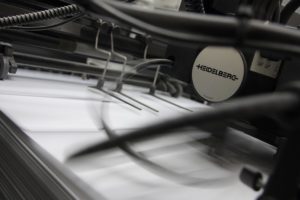 Printing technology first hit the world in the 15th century. Who would have imagined back then that a few centuries later, books will be considered outdated and digital means of communication will be slowly replacing printed media? However, printing industry – or reproducing words/images on paper, plastic or textile – is still alive and even flourishing. Basic printing methods, such as lithography, have undergone complex development and evolved into digital printing and offset printing.
Printing technology first hit the world in the 15th century. Who would have imagined back then that a few centuries later, books will be considered outdated and digital means of communication will be slowly replacing printed media? However, printing industry – or reproducing words/images on paper, plastic or textile – is still alive and even flourishing. Basic printing methods, such as lithography, have undergone complex development and evolved into digital printing and offset printing.
Offset printing method
Today’s most common printing method is known as offset printing or offset lithography. Both words (“offset” and “lithography”) can be quite deceiving, truth is the whole printing technique is much simpler than it might sound. So what does offset stands for? Offset means that the printing plate doesn’t come in direct contact with the printed surface. How the printing is possible then? A special roller is used to transfer the final image to the surface.
Offset printing comes from lithography or “stone-writing” method. Lithography was invented back in 1798 when German actor Alois Senefelder drew on a stone with a wax crayon. Applying water and ink, he then made an imprint of the wax image on paper. Modern offset printing is still using the same old-school method.
How offset printers work
The way new and used offset printers work is the following. A stone is replaced with a printing plate, otherwise the process is almost identical to the original lithography method. As a first step, image needs to be transferred onto the printing plate. As the next step, those parts of printing plate from which image is printed are lacquered in order to attract ink. Other parts of the plate are coated with gum since it attracts water and those parts need to be dipped in liquid. Printing plates lacquered in this way are then pressed against rollers (usually, a series of rollers from 2 to 8 in a row). Rollers fulfill a special mission of damping printing plates with water and then coating them with ink. However, not all parts of the plate will pick up the ink since they’ve been lacquered with clear vanish.
To transfer image to paper, printing plate is first pressed against an offset cylinder (also known as blanket cylinder). Offset cylinder helps to transfer the image as it is pressed against a sheet of paper to produce the final print. To give a general idea, modern high-speed offset printers have an output of almost 20km (around 12 miles) of printed paper in just one hour!
Used offset printers on Exapro
Types of printers
On Exapro, buyers can find used offset printers of various types. Most popular ones are 2, 4 and 5 color offset printers. What does the number stand for? It represents the number of cylinders / colors used in the particular offset printer. Number of colors generally depends on the final purpose of printing materials. Some businesses might be happy with only 1 or 2 colors. For more demanding clients, there are 4, 5 and even 8 colors offset printers. The most standard offset printing machine has 4 colors CMYK: cyan, magenta, yellow and key (black). With those colors combined, one can re-create the majority of shades. However, certain colors – like orange – can not be achieved on a 4 colors offset.
Most popular brands
- Heidelberg is the number one name in global printing industry. Heidelberg offset printers probably have the best reputation in industrial printing field. Among Heidelberg printing machines, buyers can find all possible formats, models and sizes to satisfy the most demanding needs. The model name usually indicates paper size which makes the machine choice rather simple.
- Muller Martini is nowadays a global printing empire with offices not only in Europe but also China and the USA. Muller Martini provides solutions for industrial printing sector since the middle of the 20.century. In Exapro online catalog you can easily filter used Muller Martini printing machines.



